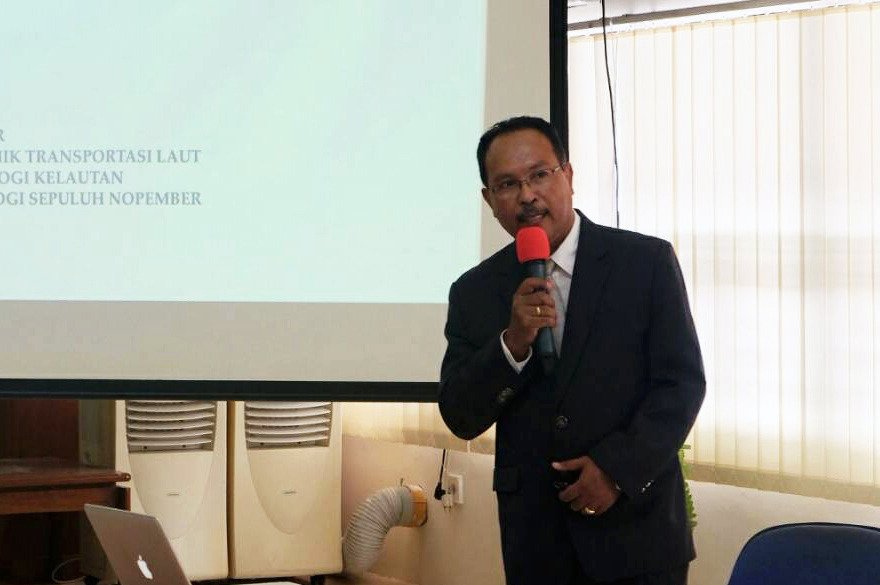Tug-Barge, Fuel Distribution Solution for Lease Islands in Maluku

Ir Edwin Matatula MT when presenting his dissertation on the BBM distribution system in Maluku in the Open Session of Doctoral Promotion in the Department of Marine Transportation Engineering, Faculty of Marine Technology (FTK) ITS
ITS Campus, ITS News – Supplying fuel oil to small islands requires a long distribution chain. Taking a case study in Lease Islands, Ir Edwin Matatula, MT gave a solution to the final chain of fuel oil distribution problems in a dissertation that he presented at the Open Session of Doctoral Promotion of Department of Marine Transportation, Institut Teknologi Sepuluh Nopember (ITS), Monday (4/3) .
Energy is one of the important commodities needed by the people of all regions, including remote island areas such as Maluku islands. Fuel oil (BBM) is currently the dominant energy commodity consumed by the public, both nationally and regionally. Based on data from the Downstream Oil and Gas Regulatory Agency, the national fuel consumption throughout 2018 is 75 million kiloliters. Whereas in the Maluku region itself, the dominant types of fuel consumed are premium, kerosene, and diesel.
Based on the research of Ir Edwin Matatula MT in his dissertation, the annual rate of fuel consumption has increased. Linearly, this increase must certainly be supported by the existence of an adequate fuel distribution infrastructure to various regions, including Lease islands. “The process of distributing fuel in the Maluku region and other island areas is generally faced with the geographical spread of the area and minimal infrastructure support,” explained the man who is often called Edwin.
The fuel oil distribution network generally consists of several service points, specifically from the terminal to the depot then to the sales agent or consumer. This service point is not on all islands. Whereas fuel transportation facilities at the final level of supply use public vessels with a port to port service system (shipping goods around the port). This transportation facility does have advantages on the side of relatively cheap and simple costs, but on the other hand, there are still many risks that shown because the ship is not designed to transport liquid cargo, especially fuel.
From a technical point of view, these ships have lacks that are quite influential. Inadequate dimensions and performance of the ship also require that the distribution process stagnates at certain times due to unfriendly weather conditions, especially when the sea wave is high. The impact of bad weather causes disruption of the supply process and availability of fuel at the consumer level. “This condition is also a trigger for fuel high prices on consumer-level at certain times,” said the alumnus of the ITS Department of Marine Transportation Engineering master’s program.
In the liquid load distribution process, there are three types of fuel transportation system to consumers, namely Tug-Barge, Self Propelled Oil Barge (SPOB) and Tanker. Based on Edwin’s analysis, there are five criteria that sharpen the choice of transportation equipment proposed later. The five criteria are logistics costs, infrastructure, ship performance, reliability, and flexibility. Based on these five criteria, Tug Barge was chosen as a system of transportation that suitable for the distribution of BBM in the Lease Islands.
The recommended system is a transportation system using transportation facilities in the form of barges as cargo space and tugboat as the driving machine. The barges itself is a wide-body floating device and equipment and generally has a deck used for transportation. Whereas tugboats are vessels with large engine power that are used to support other vessels to pull barges at the port.
The concept suggested by the Tiow-born man consisted of a tugboat and four barges. Wayame was chosen as the point of departure and the endpoint of shipping on its route of operation. For the first route, the ship departs for Nusalaut Island as the smallest island with the lowest demand for loading and unloading. Then proceed to Saparua Island by placing a barge. The return route continued towards Haruku Island with the same operation as before until the ship returned to Wayame, Ambon. “For the remaining two barges, it will be exchanged for the first barge when the barge’s contents are almost gone with the same operating route,” he explained.
The existence of a fuel transport system in the form of Tug Barge with an empty weight of 183.5 tons, explained Edwin, could be a research example for the fuel oil distribution system to other remote islands, of course with different conditions. “Because, with this system, there is a lot of convenience for the process of distribution of fuel to the next remote islands, such as the overall savings of transport unit costs reaching 41.5 percent per year,” concluded the lecturer of the Pattimura University Naval Architecture Department in Ambon. (mad/owi/Anjani)
Related News
-
ITS Rises to Second Rank in Most National PKM Funding
ITS Campus, ITS News – Strengthening its determination in the scientific field, the Institut Teknologi Sepuluh Nopember (ITS) succeeded
March 06, 2019 17:03 -
Examining Kenny, the Best ITS Bachelor Graduate with a GPA of 3.94
ITS Campus, ITS News — Educating for 3.5 years at the Institut Teknologi Sepuluh Nopember (ITS) did not prevent Benedictus
March 06, 2019 17:03 -
Inspirational, Deaf ITS Graduates Graduated with Cumlaude Predicate
ITS Campus, ITS News — An inspiring story was also present at the 129th Graduation Ceremony of the Institut Teknologi
March 06, 2019 17:03 -
129th Graduation: ITS Graduates 1,355 Candidate Leaders
ITS Campus, ITS News – Institut Teknologi Sepuluh Nopember (ITS) again held a graduation procession for its students through the
March 06, 2019 17:03
